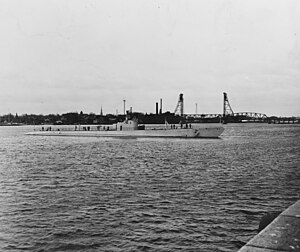Cachalot-class submarine

USS Cachalot (SS-170) the lead boat of the class
|
|
| Class overview | |
|---|---|
| Name: | Cachalot class |
| Builders: | |
| Operators: |
|
| Preceded by: | USS Dolphin (SS-169) |
| Succeeded by: | Porpoise class |
| Built: | 1931-1934 |
| In commission: | 1933-1945 |
| Completed: | 2 |
| Retired: | 2 |
| General characteristics | |
| Type: | Submarine |
| Displacement: |
|
| Length: | 260 ft (79 m) waterline, 274 ft (84 m) overall |
| Beam: | 24 ft 1 in (7.34 m) |
| Draft: | 13 ft 10 in (4.22 m) |
| Propulsion: |
|
| Speed: |
|
| Range: |
|
| Endurance: | 10 hours at 5 knots (9.3 km/h) submerged |
| Test depth: | 250 ft (76 m) |
| Complement: | 6 officers, 39 men (peacetime); 7 officers, 48 men (war) |
| Armament: |
|
The Cachalot-class submarines were a pair of medium-sized submarines of the United States Navy built under the tonnage limits of the London Naval Treaty of 1930. They were originally named V-8 and V-9, and so were known as "V-boats" even though they were unrelated to the other seven submarines (V-1 through V-7) constructed between World War I and World War II. An extensive study was conducted to determine the optimum submarine size under the treaty restrictions, factoring in total force, endurance, and percentage of the force that could be maintained on station far from a base, as in a Pacific war scenario. Joseph W. Paige of the Navy's Bureau of Construction and Repair (BuC&R) developed the basic design, but the builder, Electric Boat, was responsible for detailed arrangement; this was fairly bold, since EB had not built any new submarines since finishing four obsolescent boats for Peru. The previous V-boats were all built in naval shipyards. Cuttlefish was the first submarine built at EB's facility in Groton, Connecticut; construction of previous Electric Boat designs had been subcontracted to other shipyards, notably Fore River Shipbuilding of Quincy, Massachusetts.
Although externally much like the later "fleet submarines," internally the Cachalots were quite different. Due to pressure from the Submarine Officers Conference, they featured full double hulls adapted from the Kaiserliche Marine's U-135,direct-drive diesel-electric propulsion systems, a separate crew's mess (reinstated thanks to EB's rearrangement of the internal layout; Portsmouth would follow soon after), and considerable space around the conning tower within the large bridge fairwater (which was drastically cut down in World War II when the 3-inch (76 mm) deck gun was relocated forward of the bridge). The 3-inch gun was selected because it was felt at the time that a larger gun would encourage submarine captains to fight on the surface against superior anti-submarine ships; this remained the standard submarine deck gun until early in World War II, when war experience showed that a larger gun was needed. EB relied on electric welding for the hull, while Portsmouth clung to riveting; during the war, the riveted boats would leak fuel oil.
...
Wikipedia
